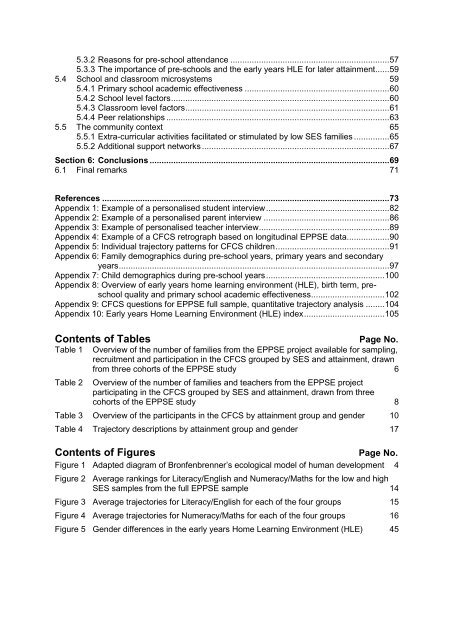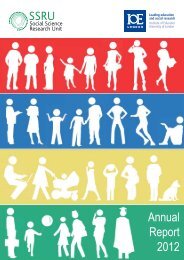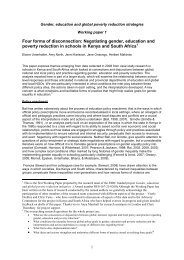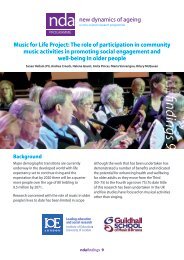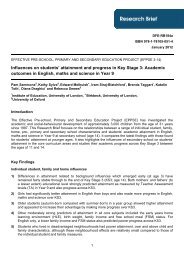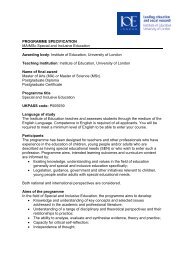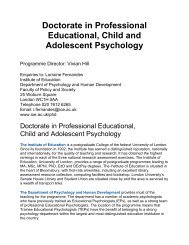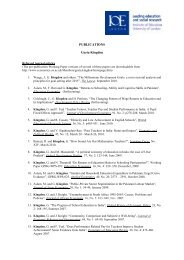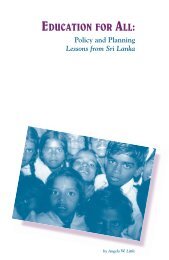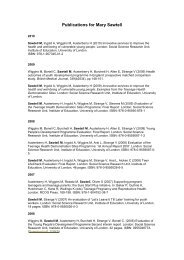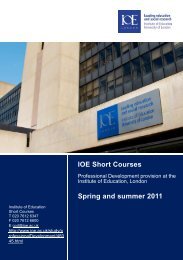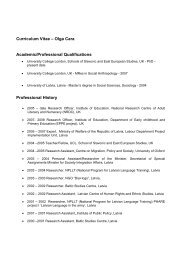Research report - Institute of Education, University of London
Research report - Institute of Education, University of London
Research report - Institute of Education, University of London
Create successful ePaper yourself
Turn your PDF publications into a flip-book with our unique Google optimized e-Paper software.
5.3.2 Reasons for pre-school attendance ................................................................... 57<br />
5.3.3 The importance <strong>of</strong> pre-schools and the early years HLE for later attainment...... 59<br />
5.4 School and classroom microsystems 59<br />
5.4.1 Primary school academic effectiveness ............................................................. 60<br />
5.4.2 School level factors ............................................................................................ 60<br />
5.4.3 Classroom level factors ...................................................................................... 61<br />
5.4.4 Peer relationships .............................................................................................. 63<br />
5.5 The community context 65<br />
5.5.1 Extra-curricular activities facilitated or stimulated by low SES families ............... 65<br />
5.5.2 Additional support networks ............................................................................... 67<br />
Section 6: Conclusions ..................................................................................................... 69<br />
6.1 Final remarks 71<br />
References ......................................................................................................................... 73<br />
Appendix 1: Example <strong>of</strong> a personalised student interview .................................................... 82<br />
Appendix 2: Example <strong>of</strong> a personalised parent interview ..................................................... 86<br />
Appendix 3: Example <strong>of</strong> personalised teacher interview ....................................................... 89<br />
Appendix 4: Example <strong>of</strong> a CFCS retrograph based on longitudinal EPPSE data.................. 90<br />
Appendix 5: Individual trajectory patterns for CFCS children ................................................ 91<br />
Appendix 6: Family demographics during pre-school years, primary years and secondary<br />
years .................................................................................................................. 97<br />
Appendix 7: Child demographics during pre-school years .................................................. 100<br />
Appendix 8: Overview <strong>of</strong> early years home learning environment (HLE), birth term, preschool<br />
quality and primary school academic effectiveness............................... 102<br />
Appendix 9: CFCS questions for EPPSE full sample, quantitative trajectory analysis ........ 104<br />
Appendix 10: Early years Home Learning Environment (HLE) index .................................. 105<br />
Contents <strong>of</strong> Tables<br />
Table 1<br />
Table 2<br />
Page No.<br />
Overview <strong>of</strong> the number <strong>of</strong> families from the EPPSE project available for sampling,<br />
recruitment and participation in the CFCS grouped by SES and attainment, drawn<br />
from three cohorts <strong>of</strong> the EPPSE study 6<br />
Overview <strong>of</strong> the number <strong>of</strong> families and teachers from the EPPSE project<br />
participating in the CFCS grouped by SES and attainment, drawn from three<br />
cohorts <strong>of</strong> the EPPSE study 8<br />
Table 3 Overview <strong>of</strong> the participants in the CFCS by attainment group and gender 10<br />
Table 4 Trajectory descriptions by attainment group and gender 17<br />
Contents <strong>of</strong> Figures<br />
Page No.<br />
Figure 1 Adapted diagram <strong>of</strong> Bronfenbrenner‟s ecological model <strong>of</strong> human development 4<br />
Figure 2 Average rankings for Literacy/English and Numeracy/Maths for the low and high<br />
SES samples from the full EPPSE sample 14<br />
Figure 3 Average trajectories for Literacy/English for each <strong>of</strong> the four groups 15<br />
Figure 4 Average trajectories for Numeracy/Maths for each <strong>of</strong> the four groups 16<br />
Figure 5 Gender differences in the early years Home Learning Environment (HLE) 45


